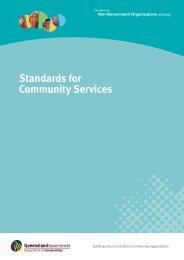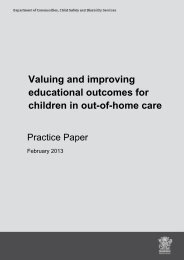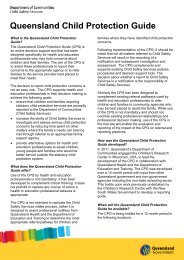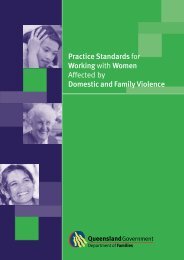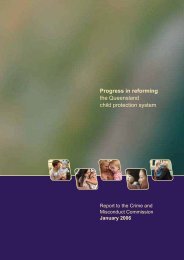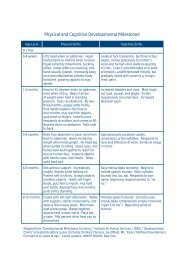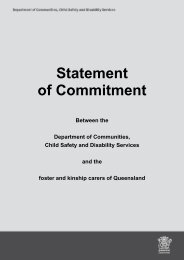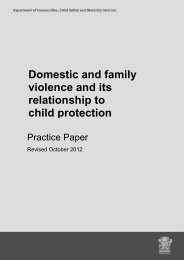Housing and Support Program (HASP): Final Evaluation Report
Housing and Support Program (HASP): Final Evaluation Report
Housing and Support Program (HASP): Final Evaluation Report
You also want an ePaper? Increase the reach of your titles
YUMPU automatically turns print PDFs into web optimized ePapers that Google loves.
available when <strong>and</strong> where needed by clients. It is<br />
clear that the provision of support services should be<br />
based on some ongoing assessment of client need,<br />
<strong>and</strong> services should be provided to match this need.<br />
In relation to <strong>HASP</strong>, there needs to be greater clarity on<br />
how decisions are made regarding the level of support<br />
provided to individuals within the model.<br />
While support agencies have greater freedom to<br />
meet client support needs within the ‘block’ funding<br />
model, there appears to be less fl exibility for clients<br />
to move between service providers. Clients wishing to<br />
transfer to another agency have to fi nd an agency with<br />
suffi cient funding capacity to cater for their support<br />
needs (since the transferring agency retains the<br />
funding). This can be especially diffi cult for consumers<br />
with large support packages. Thus, there needs to<br />
be a review of the block funding model to ensure that<br />
there is suffi cient fl exibility to enable clients to move<br />
between agencies if they so desire.<br />
Accommodation Services<br />
The provision of appropriate <strong>and</strong> affordable<br />
accommodation was considered by the clients<br />
<strong>and</strong> staff interviewed to be one of the most important<br />
components in the success of <strong>HASP</strong>. While it is clear<br />
that housing has a physical component (i.e. an<br />
identifi ed building), it also provides people with a<br />
sense of identity <strong>and</strong> ‘asylum’ from the outside world.<br />
The quality of housing has been found in previous<br />
studies to impact on the rehabilitation, functioning,<br />
<strong>and</strong> quality of life of people with mental illness.<br />
Individuals living in appropriate housing that met their<br />
needs had better outcomes at follow-up (Nelson et al.,<br />
1995; Baker & Douglas, 1990; Rosenfi eld, 1990).<br />
Having enough space was an important factor in<br />
overall satisfaction with accommodation. Clients<br />
valued having a spare bedroom for visiting family<br />
members. Others, with a fl air for art <strong>and</strong> other hobbies<br />
valued having a second bedroom which they used as a<br />
studio. However, some clients experienced diffi culties<br />
when friends of family members moved in to a spare<br />
room. Having people staying became a source of<br />
stress when these people refused to leave or began to<br />
dem<strong>and</strong> food <strong>and</strong> money from the client. Thus, careful<br />
assessment of the client <strong>and</strong> their need for additional<br />
bedrooms needs to be carried out as part of the<br />
process of allocating accommodation.<br />
The majority of <strong>HASP</strong> clients (76%) lived on their own.<br />
However, 22% felt that they would like to live with<br />
a roommate or friend in the future. The evaluation<br />
team notes that while <strong>HASP</strong> clients are not prevented<br />
from sharing accommodation, they are unable to share<br />
the support services they receive. It may be worth<br />
exploring how the program can better facilitate share<br />
housing for a small sub-group of clients who may<br />
prefer this option.<br />
Fourteen of the 80 clients in our sample had moved<br />
accommodation since joining <strong>HASP</strong>. Eleven of these<br />
had moved once, one had moved twice <strong>and</strong> two had<br />
moved thrice. There were three main reasons cited<br />
for moving — noise from neighbours <strong>and</strong> or unable<br />
to get along with neighbours (n=8), dislike of the area<br />
in which they lived (n=3), <strong>and</strong> to be closer to family<br />
(n=3). While client requests to move accommodation<br />
could be viewed as a negative for the program, it is<br />
reassuring that clients can ask to be relocated to a<br />
new neighbourhood <strong>and</strong> this appears to be feasible<br />
within <strong>HASP</strong>.<br />
It is clear that having one’s own home in the<br />
community provides a connectedness to that<br />
community. Themes that emerged from the interviews<br />
with clients suggest that stable housing plays an<br />
important role in one’s recovery. Clients viewed their<br />
housing as being important in providing stability in<br />
their lives <strong>and</strong> a platform from which to participate<br />
in the recovery process. Two other themes to emerge<br />
included a ‘sense of freedom’ <strong>and</strong> a ‘sense of home’.<br />
<strong>Housing</strong> <strong>and</strong> <strong>Support</strong> <strong>Program</strong> (<strong>HASP</strong>)<br />
67



